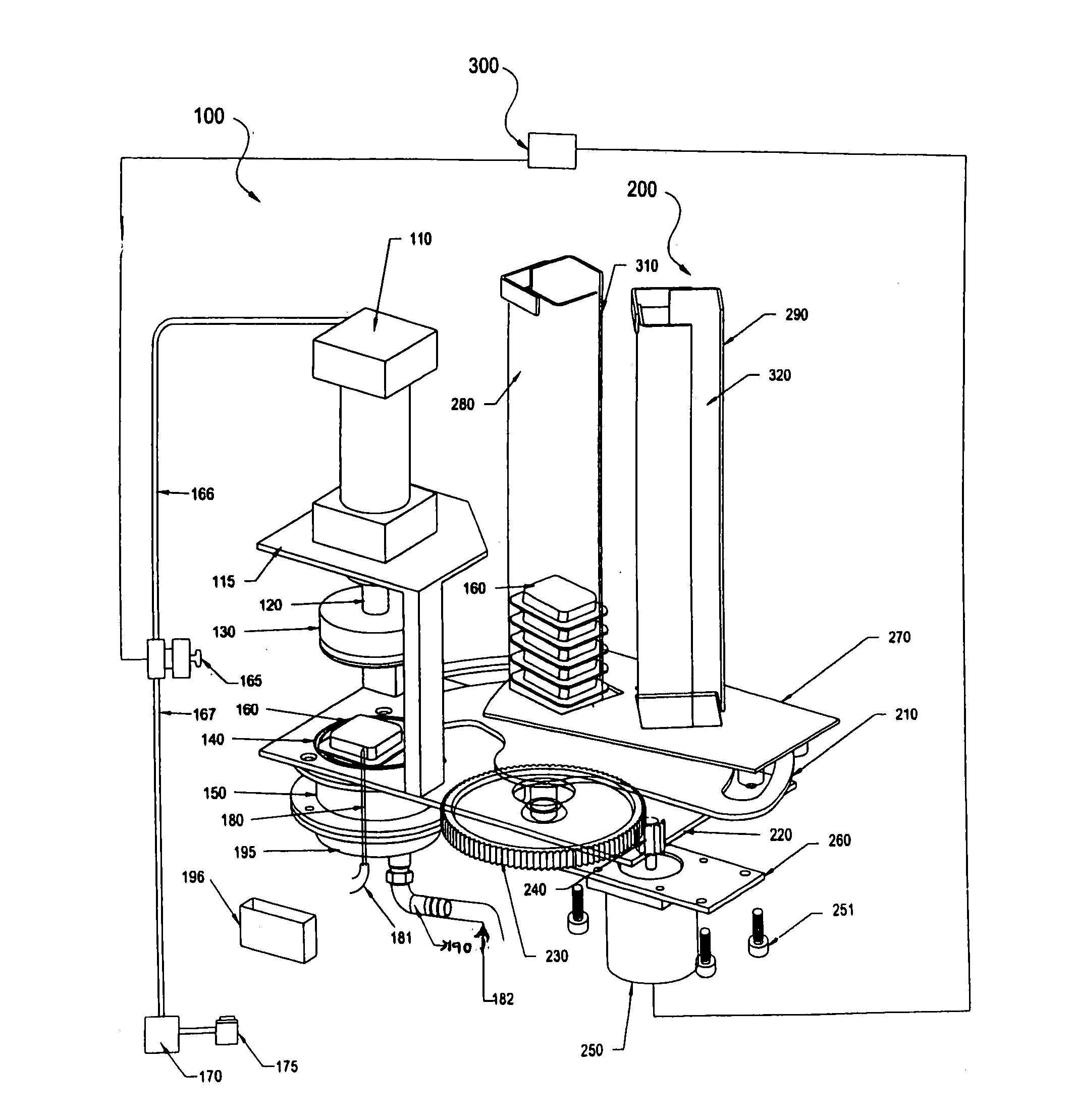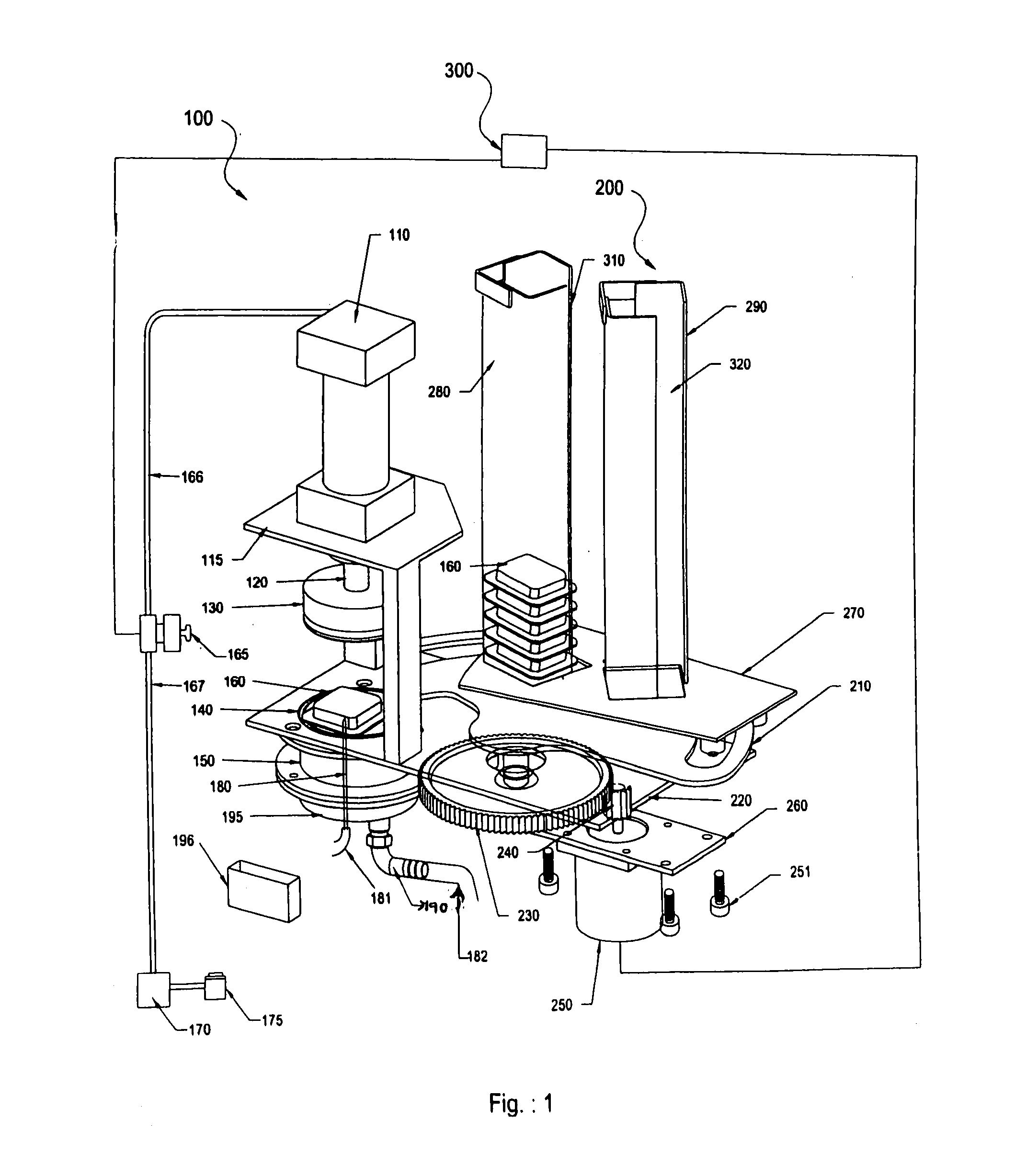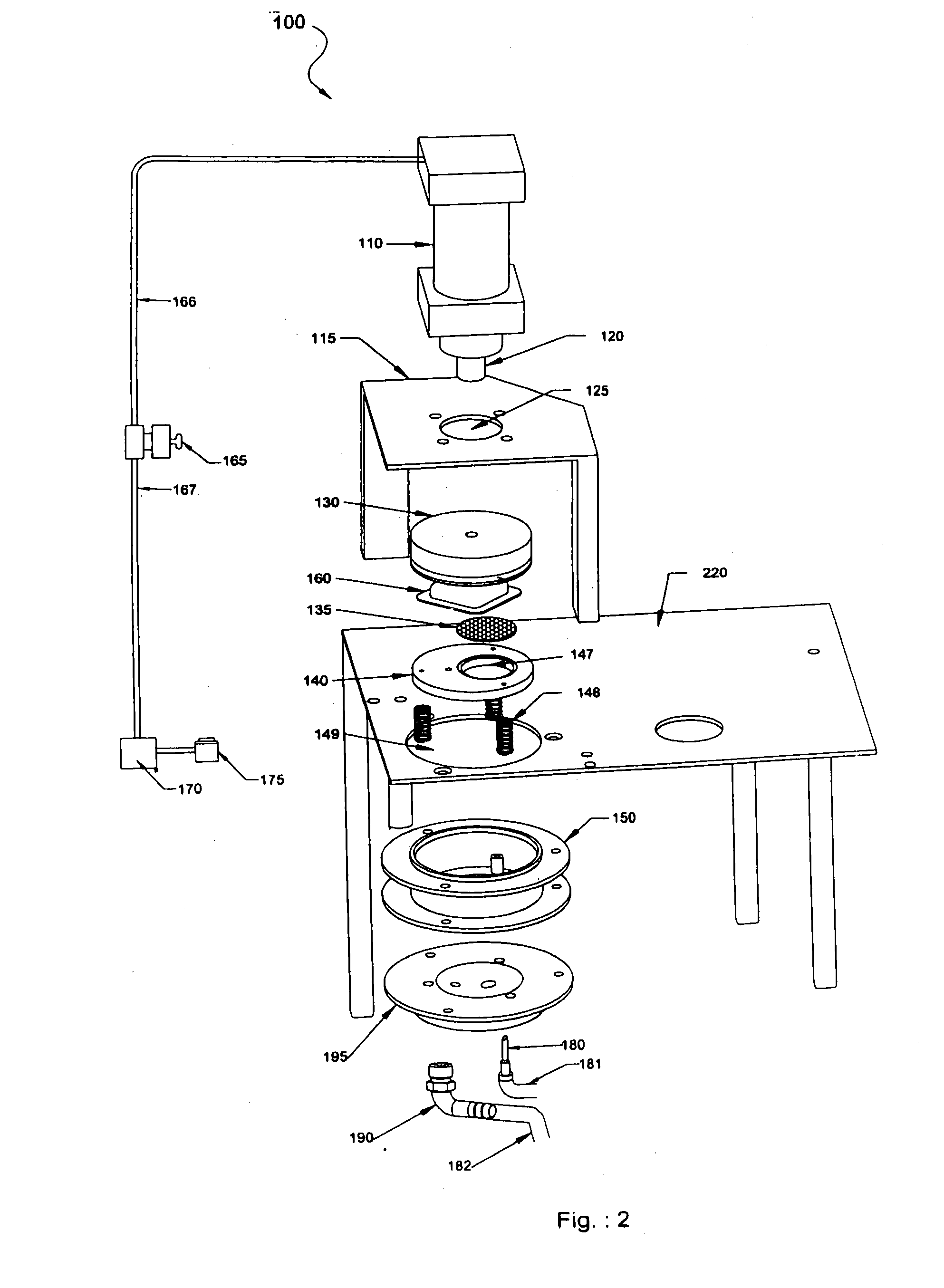Upon closure of the clamps, the
hydraulic pressure causes the flexible sheet to bulge outwards against the
injector tube resulting in piercing of the film.
A drawback of the above device is that a flap formed by a portion of the flexible film of the sachet forms a valve over the tip of the
injector tube which is presumed to be sufficiently flexible that upon injection of the liquid through the
injector tube outlet hole, the flap gets displaced to allow the liquid to enter the sachet and when the supply of liquid to injector tube stops, the
back pressure of the sachet presses the flap against the outlet hole of the injector tube thereby preventing any of the contents of the sachet from entering and clogging the injector tube.
However, the backpressure may not always be sufficient to keep the flap fully and tightly pressed against the outlet hole of injector tube with the result that the clogging of the injector tube with the contents of the sachet may occur after entry of brewing water into the sachet.
Another drawback of the above brewing arrangement is that it is applicable only to flexible containers like a sachet, wherein the
plastic film covering the sachet is capable of bulging out on application of
hydraulic pressure from one side and being pierced by the injector tube.
Still another drawback of the above brewing arrangement is that it cannot be used for sachets or cartridges formed with rigid or semi-rigid materials.
Further drawback of the above brewing arrangement is that it is not suitable for automatic operation of brewing with plurality of sachets.
The above mechanism is therefore not suitable for meeting the bulk demand in a short time in offices, ceremonial functions, etc.
Yet further drawback of the above brewing arrangement is that the injector tube may penetrate completely into the sachet and therefore the flexible film may not form the desired valve flap covering the injector outlet hole as assumed in the arrangement, due to imprecise positioning of the sachet in the brewing mechanism, thereby resulting in clogging of the injector tube with sachet contents during the flow out of the brewed liquid.
A drawback of the above device is that piercing and water injection is made from one side of the
cartridge and the brewed liquid flows out from other side.
There may not be uniform
wetting of the brewing material contained in the
cartridge due to the formation of channels within the brewing material and as such there may not be thorough brewing of the brewing material contained in the
cartridge.
Another drawback of the above
machine is that it requires complex piercer structure with multiple holes.
Still another drawback of the above
machine is that it requires a very
high pressure of 8 to 15 bars which could result in the
bursting of the cartridge due to any localized imperfection or
weakness during construction in its wall.
Additionally the cartridge needs to have a specialized design with thicker material of the wall to withstand such
high pressure which adds to the cost and complexity.
Further drawback of the above
machine is that it has complex mechanism for releasing the used cartridge.
Still further drawback of the above machine is that the cartridges require a specialized annular edge which is firmly held within the device during extraction through cooperating means.
Any misplacement of the cartridge within the device during brewing will result in deformation or
bursting of the cartridge.
This also necessitates a complex design of the cartridge holding means on the device.
Yet further drawback of the above machine is that it depends upon the
internal pressure of the brewed liquid during brewing, for the cover of the cartridge to split open along its weakening line allowing the brewed liquid to flow out.
The pressure inside may get reduced due to the brewing material and
filter paper or the pressure inside the pod may not always be adequate enough to split open the cover of the cartridge along the weakening line for the brewed liquid to flow out.
Even further drawback of the above device is that it is not suitable for automatic operation as it does not have plurality of cartridges stacked in plurality of
magazine tubes and does not have automatic means for positioning or conveying the cartridges within the brewing device.
The device is therefore not suitable for meeting the bulk demand in a short time like in offices, ceremonial functions, etc.
A drawback of the above device is that it requires multiple piercing means, one to puncture the filter cone lid for allowing the brewing water to flow into the brewing material contained in the filter cone and other to pierce the bottom of the housing to allow the flow out of the brewed liquid into a dispensing cup.
Another drawback of the above device is that it requires specialized cartridges of a complex design which would require specialized machinery to produce.
Yet another drawback of the device is that the piercing means have to puncture the base of the beverage filter cartridge which is made up of material such as
polystyrene,
polyethylene, etc, which could blunt the tip of the piercing means over a period of time, reducing the
efficacy of the mechanism.
A drawback of the above device is that the supply of brewing water into the single serving cartridge is by a complex and cumbersome mechanism involving
air pump, bladder, two flexible hoses, a shaft, a pivotal arm etc.
Another drawback is that it requires two tubular probes as piercing means, one tubular probe for piercing the container lid and the other tubular probe for the bottom of the cartridge.
Yet another drawback is that it requires a complex mechanism to first puncture the bottom of the cartridge and then puncture the lid of the cartridge in a sequence.
This sequential
puncturing of the cartridge at both ends results in slower
cycle time and the
consumer has to wait longer for the cup of beverage.
Still another
disadvantage is that it is not suitable for bulk servings as the cartridges need to be manually loaded into the brewing chamber for each cup desired to be made, thereby making it unsuitable for scenarios such as offices, ceremonial functions, etc, where high speed of dispensing is required.
Further drawback of the above device is that the second tubular device is used for piercing the bottom of the cartridge as well as being an outlet for the brewed liquid.
This tubular device may get clogged with the brewing material during the flow out of the brewed liquid.
A drawback of the above system is that the brewer requires a very complex internal mechanism to receive the cartridges, position it in perfect alignment and effect the
puncturing of the cartridge from top and bottom during the brewing process, and ejection of the used cartridge.
Another drawback of the above system is that the cartridge has to be manually loaded within the beverage filter cartridge holder by opening the slidable drawer, which makes the
system time consuming to brew a cup of beverage.
Yet another drawback of the above system is not suitable for bulk servings as there is no mechanism for automatic conveying of single serving cartridge in the cartridge holder from a cartridge storage means for plurality of cartridges.
Yet another drawback of the above system is that the lid of the brewing chamber is operated using a complex
pinion driven rack,
electric motor, vertical tracks, etc.
Additionally, the pivotal mounting of the brewing chamber on slidable drawer is of a very complex design and may get misaligned due to repeated and
frequent use, in turn causing misalignment of the beverage filter cartridge.
Further drawback of the above system is that it requires multiple piercing means, one for piercing top for inflow of hot water for brewing and another for piercing the bottom surface of the cartridge for outflow of the brewed liquid.
This adds to the complexity of the brewer design and manufacturing cost.
A drawback of the cartridges used in the above machines is that these are quite complex to manufacture and relatively expensive.
Another drawback of the above machine is that it requires four-stage
discharge cycle.
As a result, the
consumer has to wait a long time before he is able to consume his beverage.
Still another drawback of the machine is that the
consumer has to manually place the cartridge in the cartridge holder prior to operating the machine and then manually remove and dispose the used cartridge.
This slows down the
cycle time and also makes it less user-friendly.
In certain scenarios an additional operator may have to be deployed to run the machine, requiring additional manpower expenses.
Yet another drawback of the machine is that the operator has to precisely position the cartridge on the cartridge
mount such that the
handle of the cartridge is located in an irregularity on the cartridge
mount.
It is quite possible that the cartridge may be misaligned by an untrained operator or due to
human error resulting in imperfect brewing or jamming or damage to the machine, when the cartridge holder is closed by operation of the clamping lever.
Further drawback of the machine is that it has no means for stacking plurality of cartridges and automatically conveying the cartridges for brewing.
Due to this, the machine is not suitable for bulk servings in short time that is necessary for meeting demand in offices, ceremonial functions, etc.
A drawback of the above apparatus is that it requires bottom of the cartridge to be provided with slots of dimensions so as to accommodate knife-shaped inclined perforator members.
Another drawback of the above apparatus is that it is also not suitable for operation with cartridges stacked in plurality of
magazine tubes, as there is no conveying mechanism for conveying a cartridge from a
magazine tube to the brewer unit.
The above device is also therefore not suitable for meeting the bulk demand in a short time like in offices, ceremonial functions, etc.
When pressure inside the cartridge builds up to a certain level, the membrane forming the base of the cartridge gets pressed against a
pyramid profiled plate, thus getting pierced.
A drawback of the above device is that it requires multiple piercing means, a
capsule piercer for piercing one side of the
capsule for entry of water at high
temperature and pressure and a plate having multiple
pyramid-profiled points for piercing of the membrane on the other side of the
capsule for allowing the brewed liquid to flow out.
Another drawback of the above device is that there is a complex mechanism for conveying of the capsule from the magazine tube to the brewing unit which involves an actuating lever,
drive motor, driving disc, driving stud, capsule gripper, and the actuating lever being swivel mounted on a rotation bearing.
The complexity of the machine and relatively more number of moving components may cause higher operating and maintenance costs, in addition to the machine being more expensive to manufacture.
Still another
disadvantage of the above brewing assembly is that the outflow of the brewed liquid occurs through holes in the sealing membrane of the single serving capsule created by multiple
pyramid profile plate.
The miniscule particles of brewed material may flow out through these holes along with the brewed liquid thereby reducing the quality of the dispensed beverage or blocking the exit tubes that convey the brewed liquid out of the brewing unit.
Further drawback of the above assembly is that the inflow of hot water into the capsule takes place from one side and out flow of brewed liquid occurs from other side of the capsule with the result that the brewing of the brewing material contained in the pod may not be thorough as some of the brewing material particles may not be wetted.
Additionally, the arrangement of inflow of water from one side and outflow from the other side results in the design of the assembly being very complex and the brewer unit being bulky.
A drawback of the above mechanism is that the conveying and brewing mechanism, when compared to the present invention, is relatively complex in construction.
Another drawback of the above apparatus is that for piercing the foil on the top side of the capsule, there is an injector assembly, which is complex in construction, consisting of an injector head moveable in a
vertical plane by a
cam system driven by a motor.
Still another drawback of the above apparatus is that the pod cartridge used in the apparatus is relatively complex and therefore more complex to manufacture and relatively more expensive as compared to the pod of simple design used in the present invention.
The complexity of the said pod cartridge and its higher cost result in the increase in the final cost per cup of beverage to the consumers.
Further drawback in the above apparatus is that the water flows into the pod cartridge from the top and flows out through the bottom, which necessitates provision of
filter paper with apertures on one side and means for allowing the flow of water from the other side.
Another drawback of the above mechanism is that the design uses an eccentric
cam to lower the support plate and the injector head.
This
cam activated mechanism is generally slow in operation and increases the
cycle time per cup.
Yet another drawback of the system is that there is a complex mechanism for lifting the pod cartridge from the
turret aperture prior to it being pushed into the disposal bin by the sweeping arm.
 Login to View More
Login to View More  Login to View More
Login to View More 


